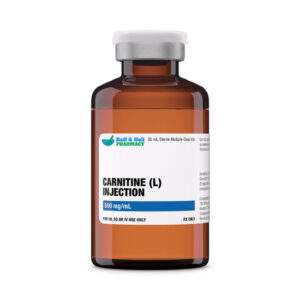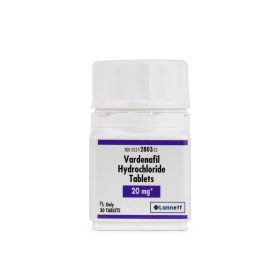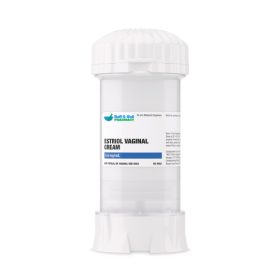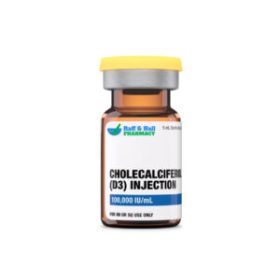Carnitine (L) Injection (30 mL Vial)
Methionine and lysine, amino acids, are used by the liver to create levocarnitine (L3hydroxy4Ntrimethylaminobutyrate). Required in energy metabolism such as the oxidation of fatty acids, this naturally occurring molecule is present in all mammalian tissues, notably striated muscle. acids improve the excretion of some organic acids and help to metabolize carbohydrates aerobically. Though the biologic system has only the L isomer, commercial carnitine production generates a D, L racemic mixture, from which the L isomer is extracted. Though it does not take part in lipid metabolism, the Disomer has pharmacological properties. Commercially, carnitine is offered both as a prescription and as a nonprescription medicine. While most dietary supplements include D,Lcarnitine—usually available in health food stores—the prescribed form is levocarnitine.
Adults and neonates with primary and secondary carnitine deficit, Alzheimer’s disease, dilated cardiomyopathy in adults and children, have benefited from treatment with levocarnitine. Hyperlipoproteinemia and valproic acid-induced liver toxicity in children. For several reasons, it has been classified an orphan medication. Its efficacy in alcoholism caused fatty liver, Down’s syndrome, and chronic fatigue syndrome has varied. Some athletes take carnitine supplements to boost exercise performance, yet the idea of carnitine loading does not seem to be especially effective. D, Lcarnitine also competitively inhibits levocarnitine, therefore creating a deficiency. In 1985 (tablets), 1986 (oral solution), and 1992 (injection), the FDA authorized prescription forms of levocarnitine.
Levocarnitine helps to move long-chain fatty acids from the cytoplasm to the mitochondria, therefore supplying oxidation and later cellular energy production substrates. In individuals with deficiencies in fatty acid metabolism or particular organic acidopathies accumulating acyl CoA esters, levocarnitine can help with the excretion of surplus organic or fatty acids.
Found in the cytosol and mitochondrial membranes, carnitine acetyltransferases (CATs) catalyze the interconversion of fatty acid esters of coenzyme A and carnitine. Found in mitochondrial membranes, translocases rapidly move free carnitine as well as its esters into and out of cells. Formed in the cytosol, CoA’s fatty acid esters inhibit enzymes of the Krebs cycle and take part in oxidative phosphorylation. Therefore, oxidation of fatty acids necessitates generation of acylcarnitines and their transport into mitochondria, where CoA esters are reestablished and metabolized. Carnitine helps to keep an ideal free to esterified CoA ratio inside mitochondria for oxidative phosphorylation and oxygen tension restrictions. for acetyl CoA consumption.
In patients with diarrhea, levocarnitine should be used sparingly as it could result in gastrointestinal symptoms.
Categorization of levocarnitine is B in pregnancy. At dosages up to 3.8 times the human dose, reproductive experiments in rats and rabbits have been carried out. have also claimed no evidence of damaged fertility or harm to the fetus. There are no good, well controlled trials on pregnant women. Only under clearly required circumstances should this medication be used during pregnancy.
Treatment with levocarnitine has been linked with more frequent seizures. Patients with a history of a seizure disorder should be given this medicine carefully.
Even while levocarnitine is used in some forms of cardiomyopathy treatment, it must be given to patients with a history of cardiac problems or cardiac dysfunction with care. Intravenous levocarnitine in dialysis patients has been linked to several cardiovascular side effects including hypertension, peripheral edema, and ventricular arrhythmias.
Levocarnitine therapy could aggravate peripheral neuropathy.
Oral levocarnitine has not been assessed for safety or effectiveness in renal failure. Do not prescribe oral levocarnitine to those with significant renal failure or impairment, including those undergoing dialysis. Trimethylamine [TMA] and trimethylamineNoxide [TMAO], the main metabolites produced after chronic oral administration, will accumulate in renal failure patients since they cannot be by the kidneys (manufacturer information). Since it increases the amount of nitrogenous waste to be extracted during dialysis, the gathering of these possibly harmful metabolites is not ideal. Furthermore reported to be linked to probable neurophysiologic impacts are higher levels of TMA in dialysis patients. Developments of a “fishy” body odor may arise from poor elimination of these metabolites. Only the intravenous form of levocarnitine is indicated for usage in ESRD patients on hemodialysis; accumulation of metabolites does not occur to the same extent following intravenous administration of levocarnitine.
In hepatic illness, exercise levocarnitine carefully as no particular data exists.
Although levocarnitine is a regular element of human milk needed for fat metabolism, studies on supplementation with it in nursing women have not been specifically conducted. Levocarnitine use within the usual range of dietary intake causes excretion into the breastmilk, which is rather steady.
These gastrointestinal symptoms include vomiting, nausea, gastritis, dyspepsia, diarrhoea, and stomach pain. Slowing the rate of intake and giving divided dosages across the day can help to lessen these side effects with oral treatment. GI side effects were noted at the following incidence in comparison to placebo during clinical trials of IV levocarnitine in individuals on chronic hemodialysis: abdominal discomfort (5—21% vs 17%)
Patients with and without a history of seizures have had levocarnitine treatment linked with seizures and a rise in seizure activity (frequency and/or severity). Patients with a history of seizures should be given it very slowly.
Cardiovascular side effects were noted at the following prevalence in patients on chronic hemodialysis during IV levocarnatine clinical trials compared to placebo: arrhythmias (2—3% vs 5%),
Pregnant women have no sufficient, properly controlled research. Only if absolutely necessary should this medicine be used during pregnancy.
While levocarnitine is a natural component of human milk needed for fat metabolism, supplementation with it in nursing women has not been thoroughly investigated. Under the direction of a healthcare expert, women with carnitine deficiency and premature newborns might need prescription levocarnitine supplementation. In dairy cows, levocarnitine has been researched; data show that following external administration of levocarnitine, milk’s concentration of levocarnitine rises. Any hazards to the infant of too much carnitine intake need to be balanced against the advantages of levocarnitine supplementation to the mother in nursing mothers getting levocarnitine. One might think about stopping nursing or of levocarnitine therapy.
Store this medication at 68°F to 77°F (20°C to 25°C) and away from heat, moisture and light. Keep all medicine out of the reach of children. Throw away any unused medicine after the beyond use date. Do not flush unused medications or pour down a sink or drain.
- Brass EP. Supplemental carnitine and exercise. Am J Clin Nutr 2000;72(suppl):618S-623S.
- Carnitor (levocarnitine) injection package insert. Gaithersburg, MD: Sigma Tau Pharmaceuticals; 2015 Apr.
- Carnitor (levocarnitine) tablets, oral solution, and sugar-free oral solution package insert. Gaithersburg, MD: Sigma Tau Pharmaceuticals; 2015 Apr.





